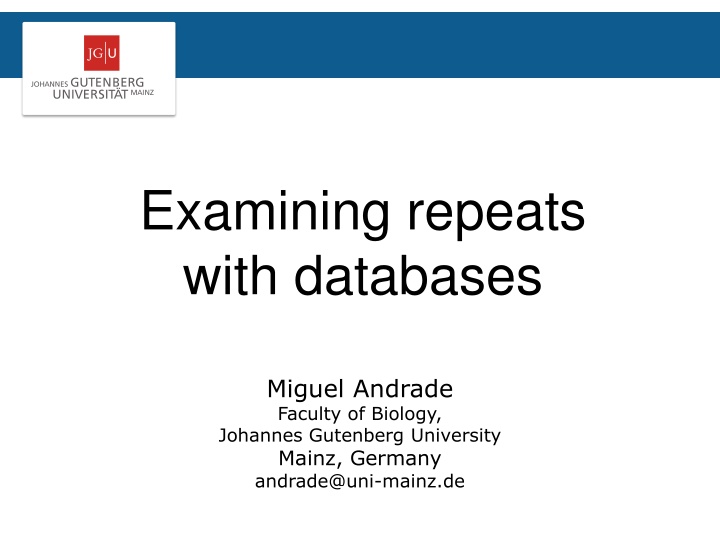
Exploring Repeat Structures and Evolution in Biological Databases
Dive into the world of repeat structures with databases like RepeatsDB, examining their accuracy and evolutionary patterns. Explore homorepeats in 50 species and align them using dAPE, uncovering insights into polyX evolution. Learn how to analyze repeat units and evaluate their correctness in this fascinating biological dataset.
Download Presentation

Please find below an Image/Link to download the presentation.
The content on the website is provided AS IS for your information and personal use only. It may not be sold, licensed, or shared on other websites without obtaining consent from the author. If you encounter any issues during the download, it is possible that the publisher has removed the file from their server.
You are allowed to download the files provided on this website for personal or commercial use, subject to the condition that they are used lawfully. All files are the property of their respective owners.
The content on the website is provided AS IS for your information and personal use only. It may not be sold, licensed, or shared on other websites without obtaining consent from the author.
E N D
Presentation Transcript
Examining repeats with databases Miguel Andrade Faculty of Biology, Johannes Gutenberg University Mainz, Germany andrade@uni-mainz.de
RepeatsDB https://repeatsdb.bio.unipd.it/structure/3vbpA
Exercise 1. Examining repeat structures in repeatsDB Go to RepeatsDB: http://repeatsdb.bio.unipd.it/ Click the Search tab, then search Repeat unit number Choose one example and write down the PDB name (e.g. 6yc3B). Check the assignment of the units. Is it correct? What about insertions? Are there mistakes? Write an evaluation: Looks good / one repeat wrong / many mistakes / total mess
Example https://repeatsdb.bio.unipd.it/structure/5cxbB 1. looks good 2. one repeat wrong 3. many mistakes 4. total mess
Evolution of homorepeats in 50 species Pablo Mier
Context and evolution of homorepeats dAtabase of PolyX Evolution Mier et al. (2016) Bioinformatics
Context and evolution of homorepeats dAtabase of PolyX Evolution Mier et al. (2016) Bioinformatics
Exercise 2. Viewing homorepeats in an alignment with dAPE Find a random human protein in UniProt. Make sure that it is a reviewed entry. Write the Entry Name.
Exercise 2. Viewing homorepeats in an alignment with dAPE Find a random human protein in UniProt. Make sure that it is a reviewed entry. Write the Entry Name. Copy the Entry ID (e.g. P10275). Go to the dAPE web page: http://cbdm-01.zdv.uni-mainz.de/~munoz/polyx/ Use the Entry ID in option A Hit the Report the evolution of its polyX" button Write down: (1) Which type of polyX has the human protein? (2) Which additional polyX not in the human protein were found in the orthologs?
Exercise 3. Find structures of short repeats Go to the PDB web page: https://www.rcsb.org/ Go to Search > Advanced Search Type a short repeat in the Sequence Motif: as many repeats as possible; Use Mode PROSITE and RegExp (example: QQQQ / another example: [SP]SA[SP]SA[SP]SA ) Click count to see if there are any cases Check the structure (3D View) to see if the repeat is in the structure (it could be disordered = absent) Write down the PDB name, RegExp and structure Example 3NB9 QQQQ alpha-helix Example 3FRC NNNN absent
